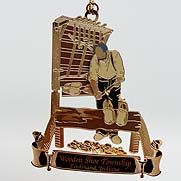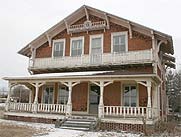2008 Essays — 1st Place – Risky Business in the Creek: The Turtle Hunting Experience by Nicole Kersteins
Age is nothing but a number, but it is other things, too. It is wisdom if one has lived one’s life properly. It is experience and knowledge. And it is getting to know all the ways the world turns. —Miriam Makeba
Our elders have been through many substantial events in their lives. Whether or not the outcomes of these events seemed important at the time, the results have caused our elders to grow and learn something from every single one. They have gained knowledge and wisdom through their experiences and will never forget the many memories that have influenced their lives. It is my generation’s responsibility to ask questions and listen to the stories our grandparents have to share with us. The lessons they teach us through these stories can have an impact on our lives as well. I enjoy talking with my grandparents and listening to stories of the past. While talking with my grandpa Gene Henke, I was able to learn about an interesting experience of his from when he was my age.
During his teenage years, my grandpa went hunting with his dad, brother, uncle, and a friend of his uncle. His uncle was always the driver because he was once in a car wreck that caused him to become crippled, and my grandpa always got stuck with the job of carrying the bag of turtles because he was the youngest. They would mostly go hunting at a creek located about 45 miles north of Jasper called 1st Creek. This creek and the other they hunted in usually averaged about fifteen to twenty feet wide. Because there wouldn’t have been enough time during the week, they always went on weekends; it was an all day event. My grandpa said turtle hunting “eats up a lot of hours.” They would go to church the night before or wake up very early the next morning to go. After eating breakfast, they packed other food for dinner and snacks for the day; if they were running late, they would eat breakfast on the way. They took a set of old clothes along and changed into these clothes when they arrived at the creek where they would be hunting. Bridges crossed the creek about seven to ten miles apart from each other, and the hunters hunted from bridge to bridge. They had to walk about an average of seven to ten miles between bridges and drag the turtles they aught along with them in a bag. Once they arrived at a bridge, they stopped to drop off the turtles in the trunk of the car and eat. As soon as they reached the stopping point at the bridge, they scarfed down their food because they were so hungry. It took about five to seven hours to make it from one bridge to the next. If they would have more time, they’d hunt to the next bridge; however, they usually just went from one bridge to the next at a time. When they first started hunting at the beginning of the day, everyone was talkative and in a good mood. By the end of the hunt, they joked and laughed less because they were so exhausted. Everyone became excited when they could finally see the parked car on the bridge waiting for them.
When they decided to call it a day, they changed into clean clothes again because they were all muddy. My grandpa said, “The rotten leaves and mud in the water smelled almost as bad as sewage sometimes. Walking in the water and mud in the creeks made hunting difficult. It seemed like we put on two to three times the mileage we actually went. It was rough.” By the time they made it home, they were worn out. Since it was close to supper time and almost dark, they were ready to clean up and go to bed. Bringing home ten to fifteen turtles was considered a good hunt for the day. The turtles that they caught ranged from weighing two pounds to 24 pounds. Any turtle weighing less than two pounds would be let go to allow the population to keep growing.
Turtle hunting posed many dangers and involved taking some risks. Barbed wire in the drifts, debris and broken glass in the water, and random deep holes and drop-offs in the creeks were some dangers. Because they were always barehanded while reaching for the turtles, they had to be careful of not getting cuts from the glass and other debris. A serious cut from the glass could turn into a critical problem when they were hunting in a creek because they weren’t near any medical facilities. At some places they had to get out of the creek if it was not suitable for hunting, and they had to walk through patches of thick green briers and poison ivy for possibly hundreds of feet at time. Snakes were also a danger, but they usually left the hunters alone and just swam by if they weren’t bothered. However, if they would have grabbed the snake, it probably would have bitten them. His advice about snakes was, “If a snake bites you, bite it back.” The turtle were usually found under drifts in the creek or under creek banks, but hunting under creek banks could also be dangerous because other animals could be hiding in those hollow places.
Identifying the turtle was an important process; it was easy to get bitten if they were not careful. To identify the turtle, they had to put their fingers around the top of the shell and feel for the jagged edge, which is the tail end. Once they felt the jagged edge, they wanted to grab the turtle by its tail. Because its leg muscles are so strong, the turtle was impossible to catch if they grabbed it by a leg. Also, if they would catch it by getting one hand on each side of the shell, it would use its legs and claws to push their hands off. Aggressive animals able to lunge a couple inches forward, the turtles tried to bite every chance they had. Although they have no teeth, they have gums with razor sharp edges. Once the turtle was caught, it was immediately put into an old empty fifty-pound potato sack that they carried with them. In addition to biting the person carrying the bag, the turtles also tried to bite the other turtles in the bag. If a turtle would bite you, your immediate reaction would be to jerk away, but this the wrong thing to do. Jerking away once is has bitten you will cause your skin to tear away in the turtle’s mouth. Even though it hurts, the best thing to do is to not move and wait until it lets go. If a big enough turtle would bite your finger, it could break the bone.
Many interesting events happened during the hunts that made the day exciting. My grandpa explained that the variety of wildlife was a spectacular sight, and he enjoyed seeing all of the animals near the creeks. Normally the water was a couple of feet deep, but occasionally there would be drop-offs. Because of all the mud and debris that made the water unclear, it was impossible to see how deep the water was at times. If one of the hunters wouldn’t be aware of a drop-off in the creek, all of a sudden he would fall under water and come up gasping. Everyone would just laugh and keep on going because this was something that happened fairly often. The pants they were wearing could also get stuck on barbed wire hanging from the drifts and rip; this unfortunate event caused a few laughs from the others as well.
Considered a delicacy, turtle meat was wanted by many because it had such a delicious taste. The meat was mostly used for making turtle soup and fried turtle. They used the larger turtles for soup because the meat was tougher; the smaller turtles were better for frying. To make the meat even more tender, they could steam it in the oven for a few hours.
The butchering process involved many steps. To make the turtle stick its head out of its shell and open its mouth, the hunters aggravated the turtle with a large pliers. Putting a foot on its back, they clamped down on the turtle’s head with the pliers and pulled the head out as far as they could. Using a hatchet, they then chopped off all the feet and the head a couple inches behind the eyes and wait for the turtle to bleed out. They would do this to all the turtles that were to be cleaned. Although the head was off at this point, they were advised not to play around with it until several hours later because the mouth could still snap at them because of the nerves. Once the turtle had bled out, it was time for the turtle to be skinned. The hunters had to use a large sharp knife to split the skin from head to tail and cut the meat away from the hard leathery skin. Then they would cut out chunks of meat from the main part of the body and put them in a bowl of cold water. Some meat was located on the backbone, and this meat was used only for making soup because it took time to remove. Surprisingly, some of the butchered turtles still had eggs inside of them that they had not laid.
Although everyone loved to have turtle meat, few actually wanted to go through the trouble of hunting because it was such a difficult and time-consuming task. When asked about the most important lesson he would want my generation to remember from this experience, he stated, “It was a good experience and hard work but still a lot of fun. I think it would be good for your generation to give turtle hunting by hand a try — trapping them is too easy!”



